Intel Comet Lake-S Arrives: More Cores, Higher Boosts and Power Draw, but Better Pricing
Kick the tires and light the TDP fires
Full Intel 10th-Gen Comet Lake-S Slide Deck


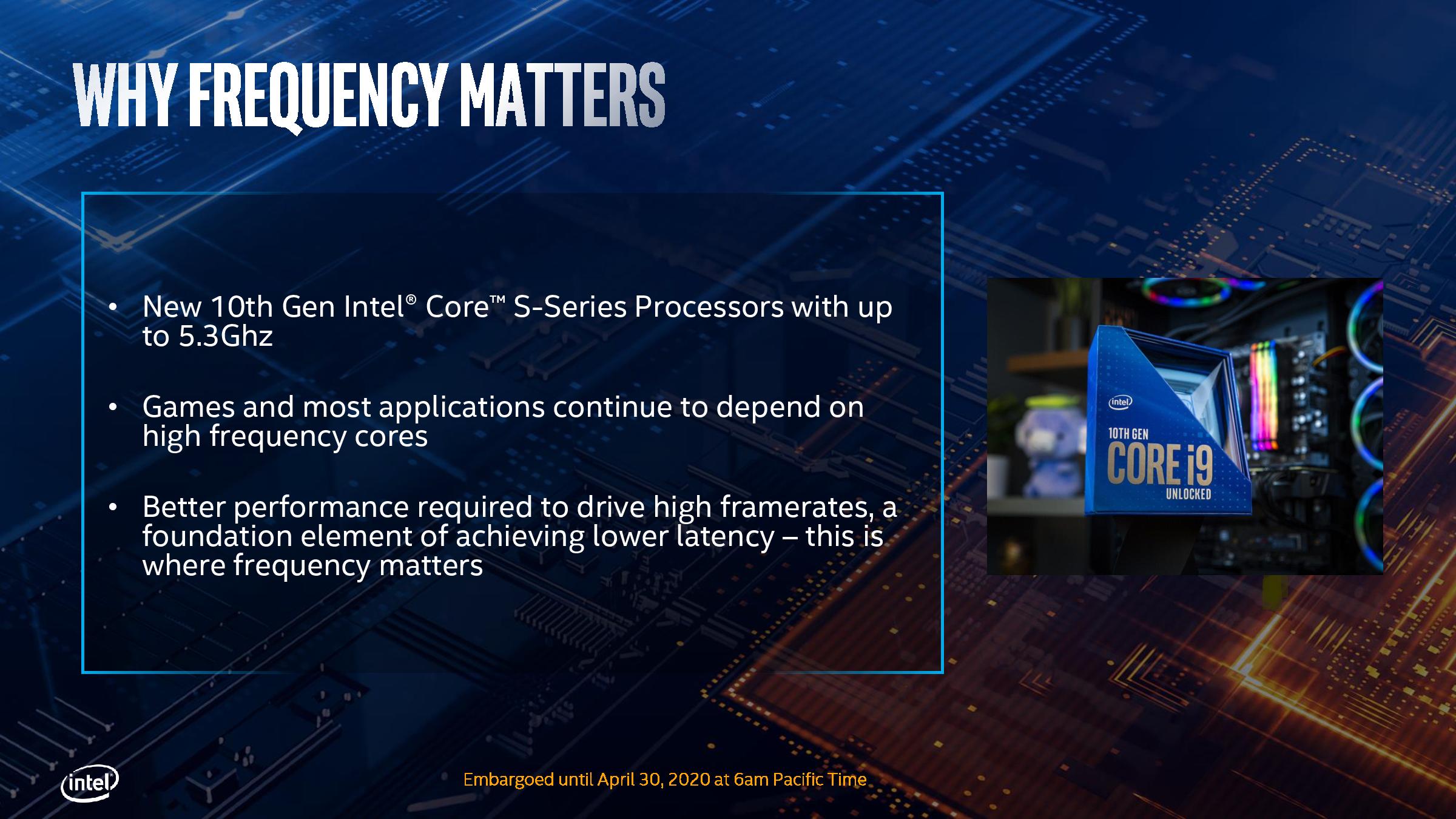
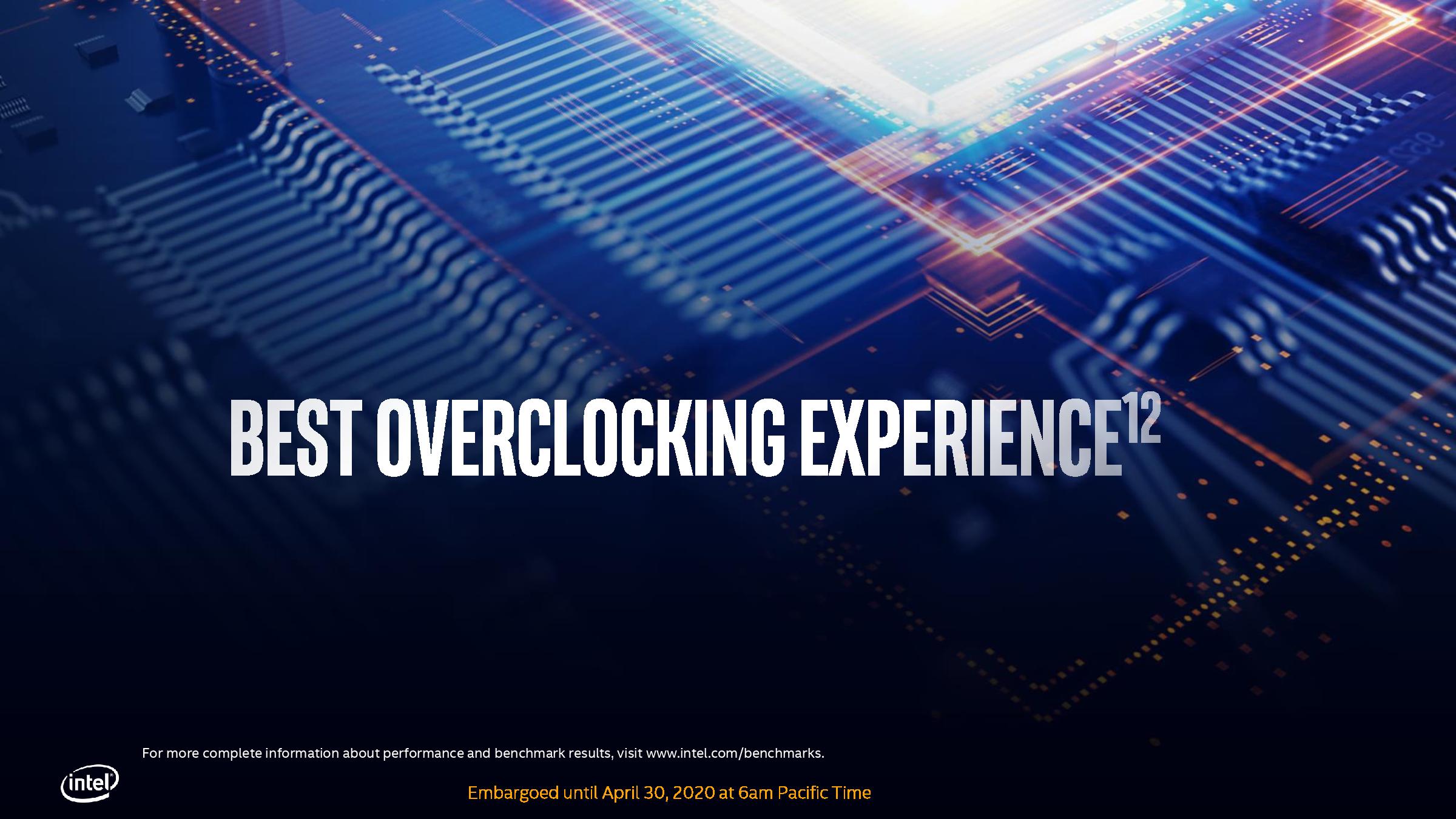




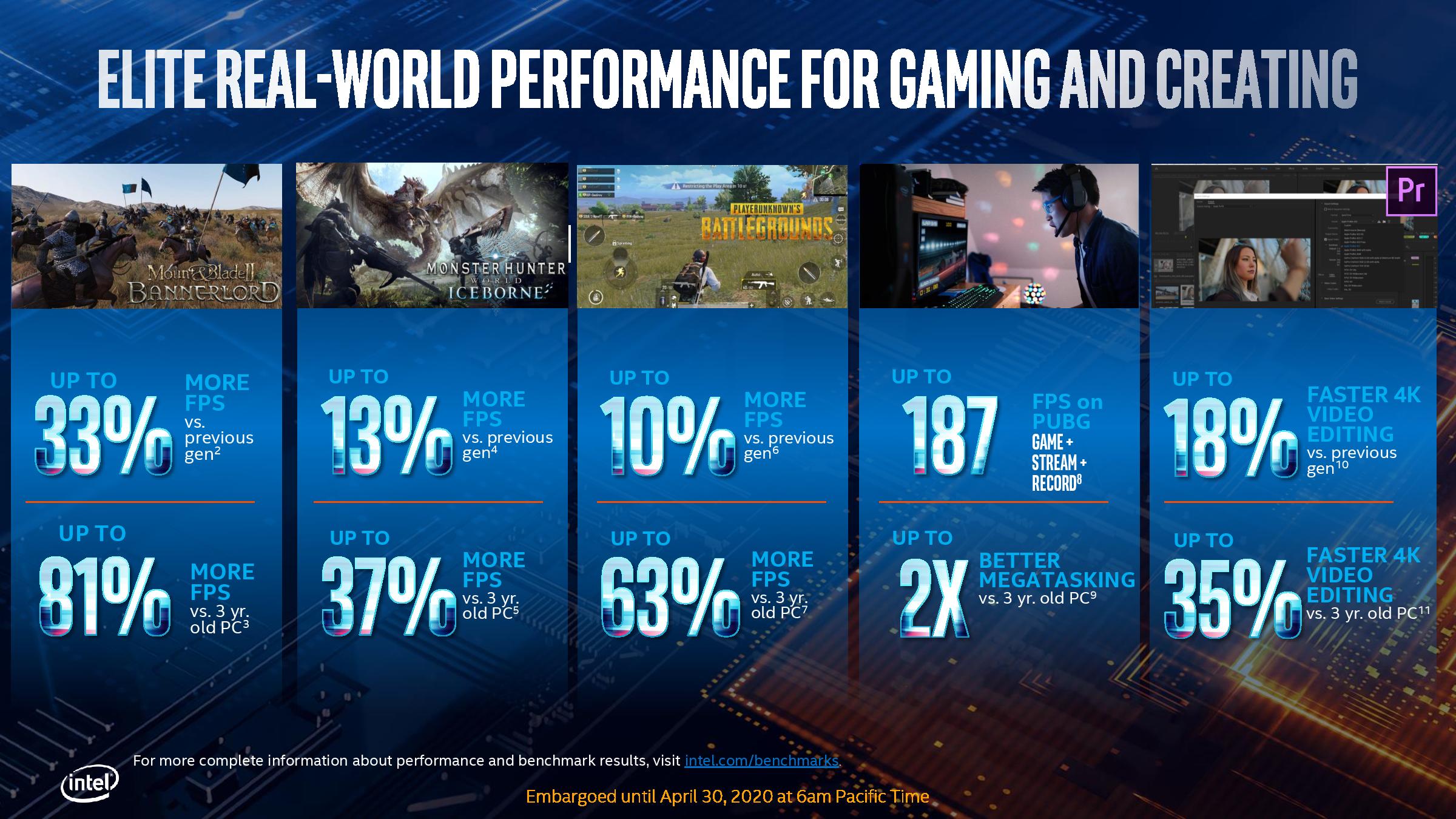

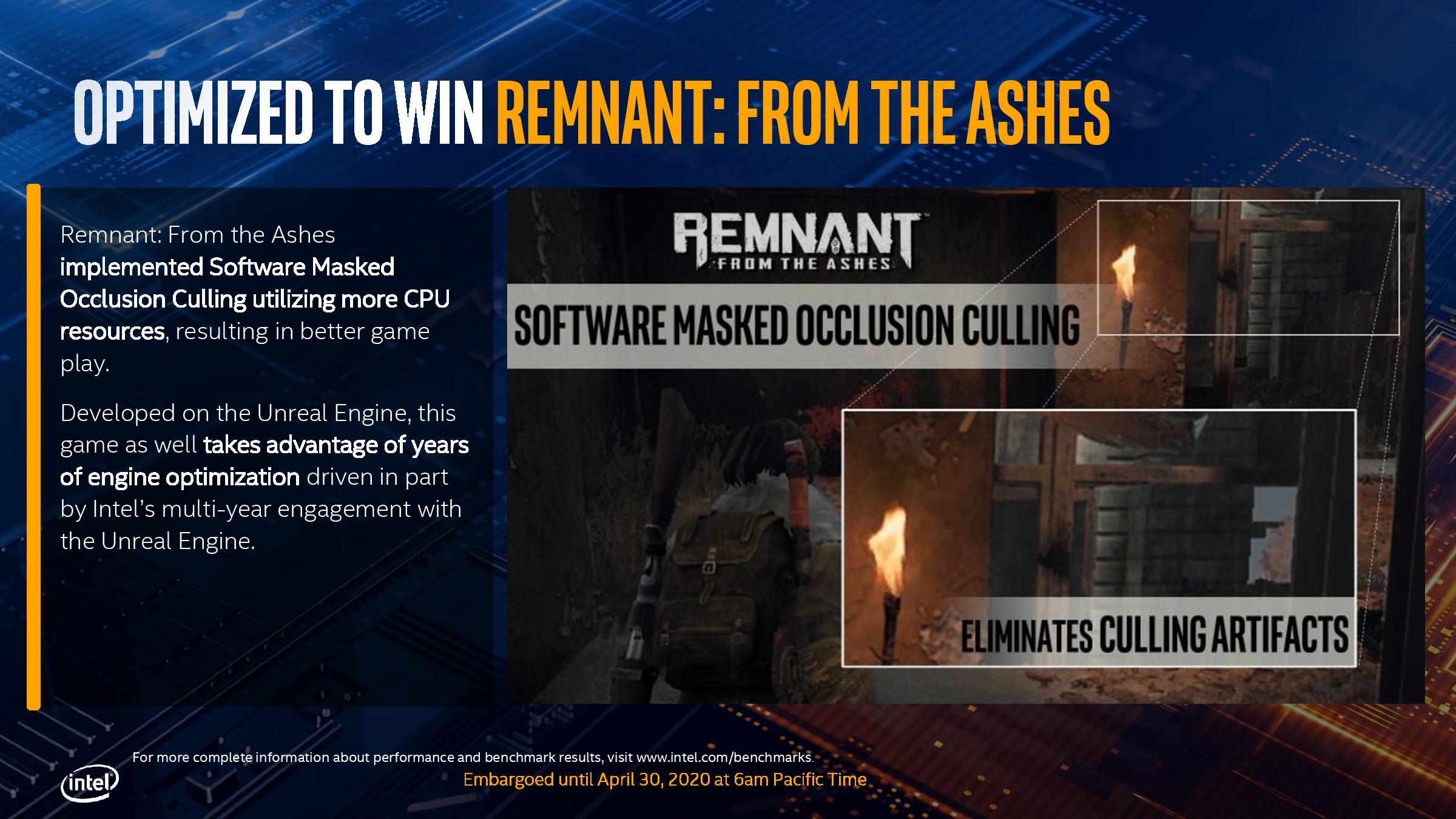



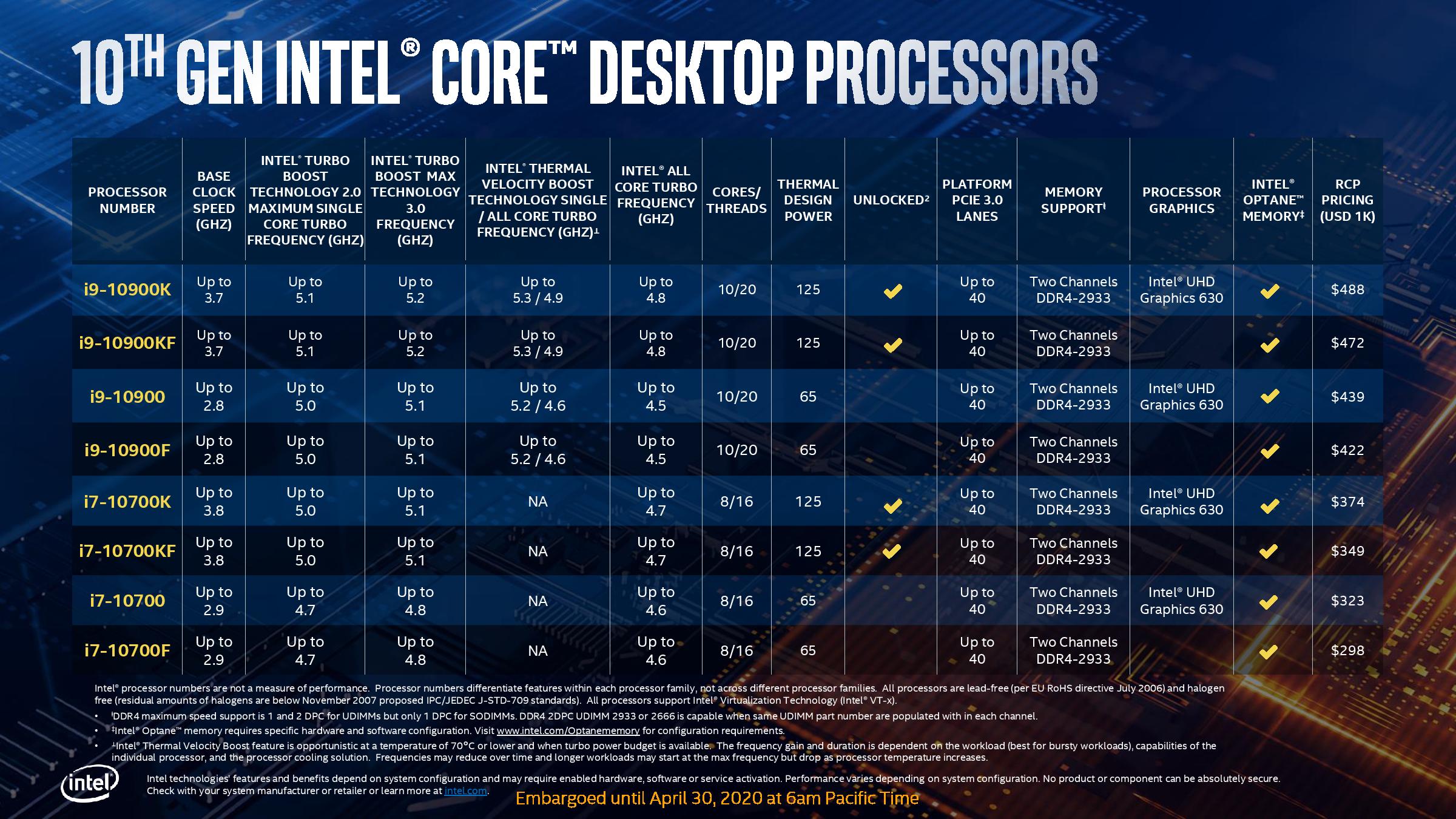

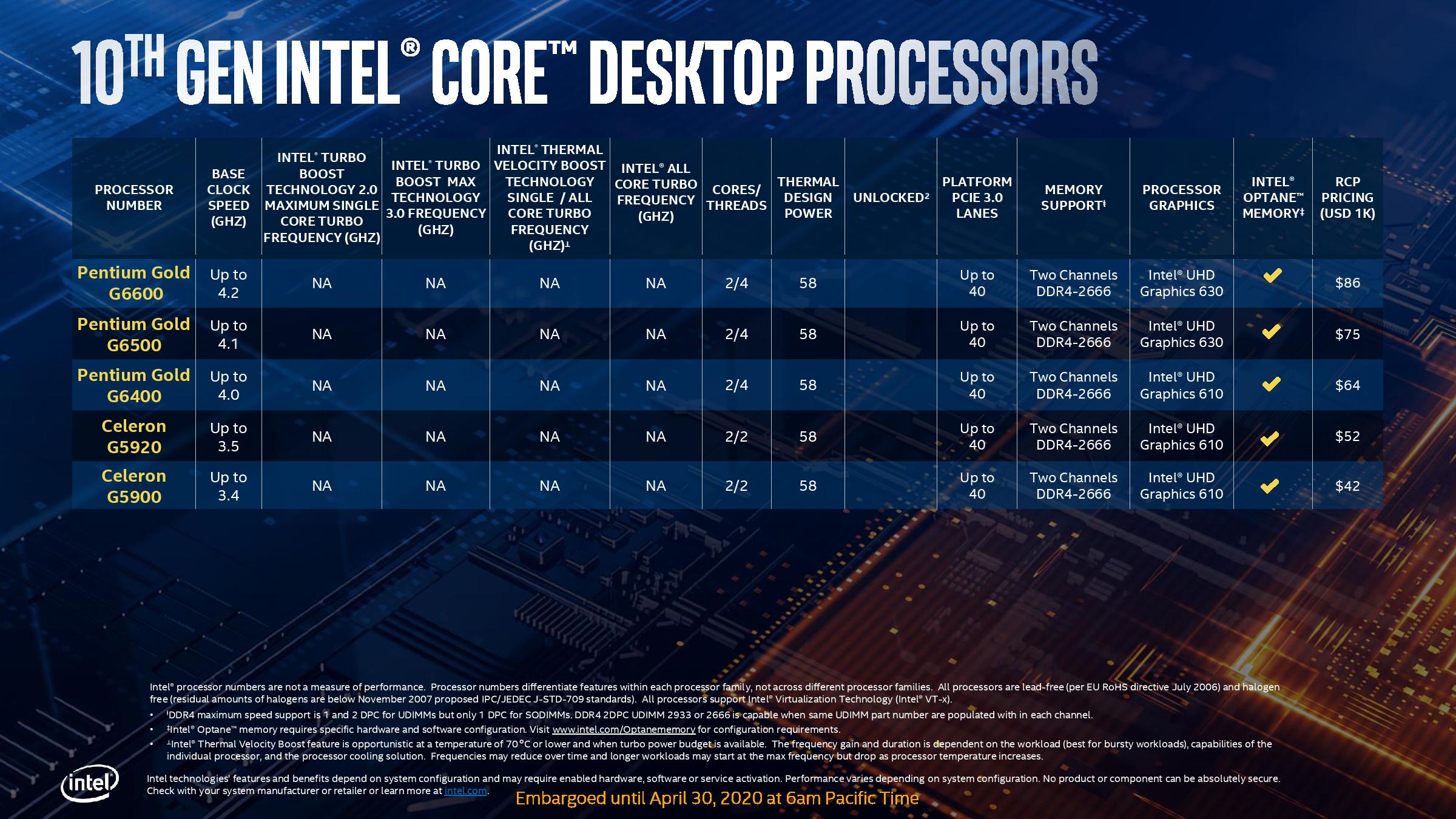
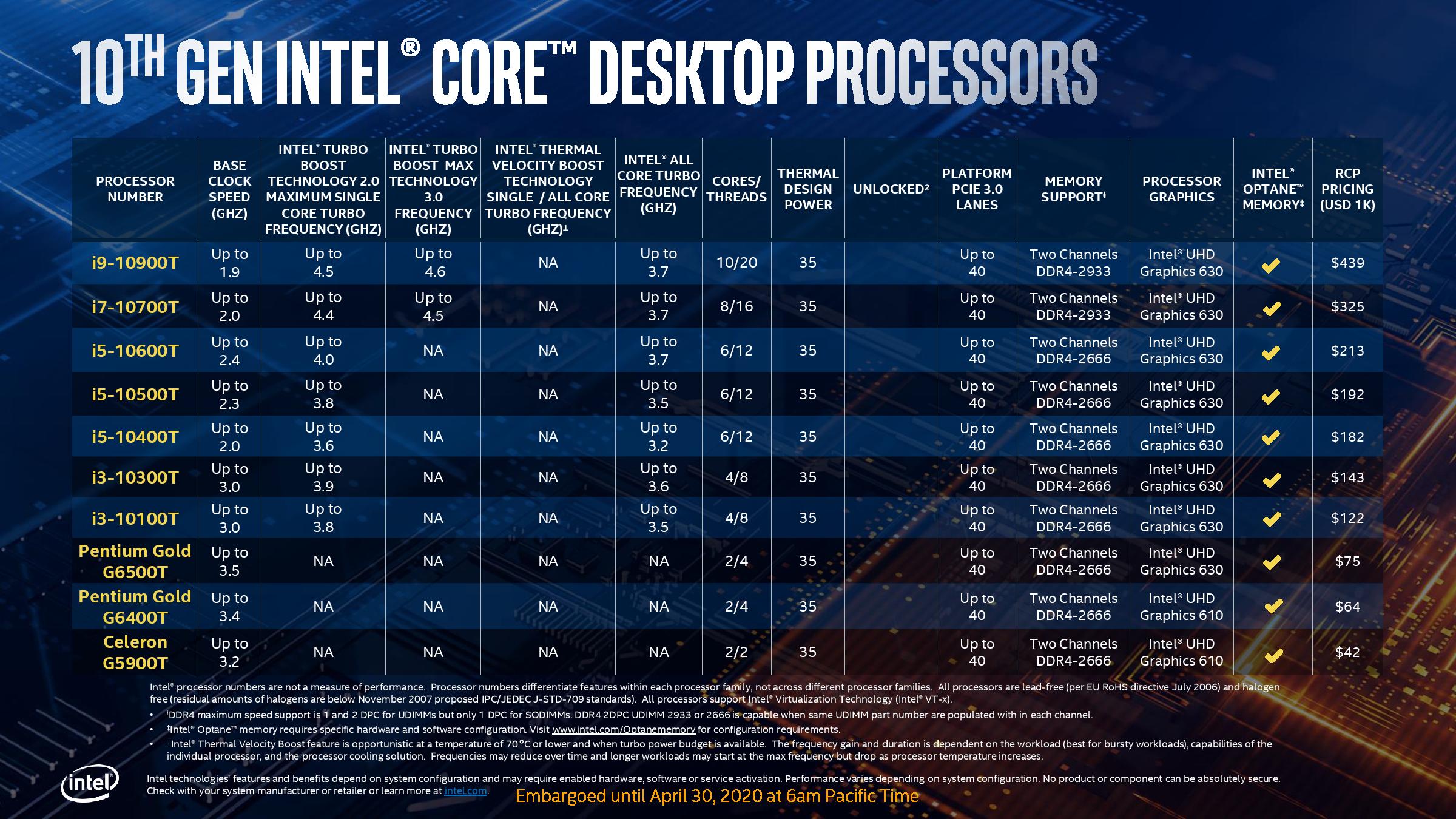


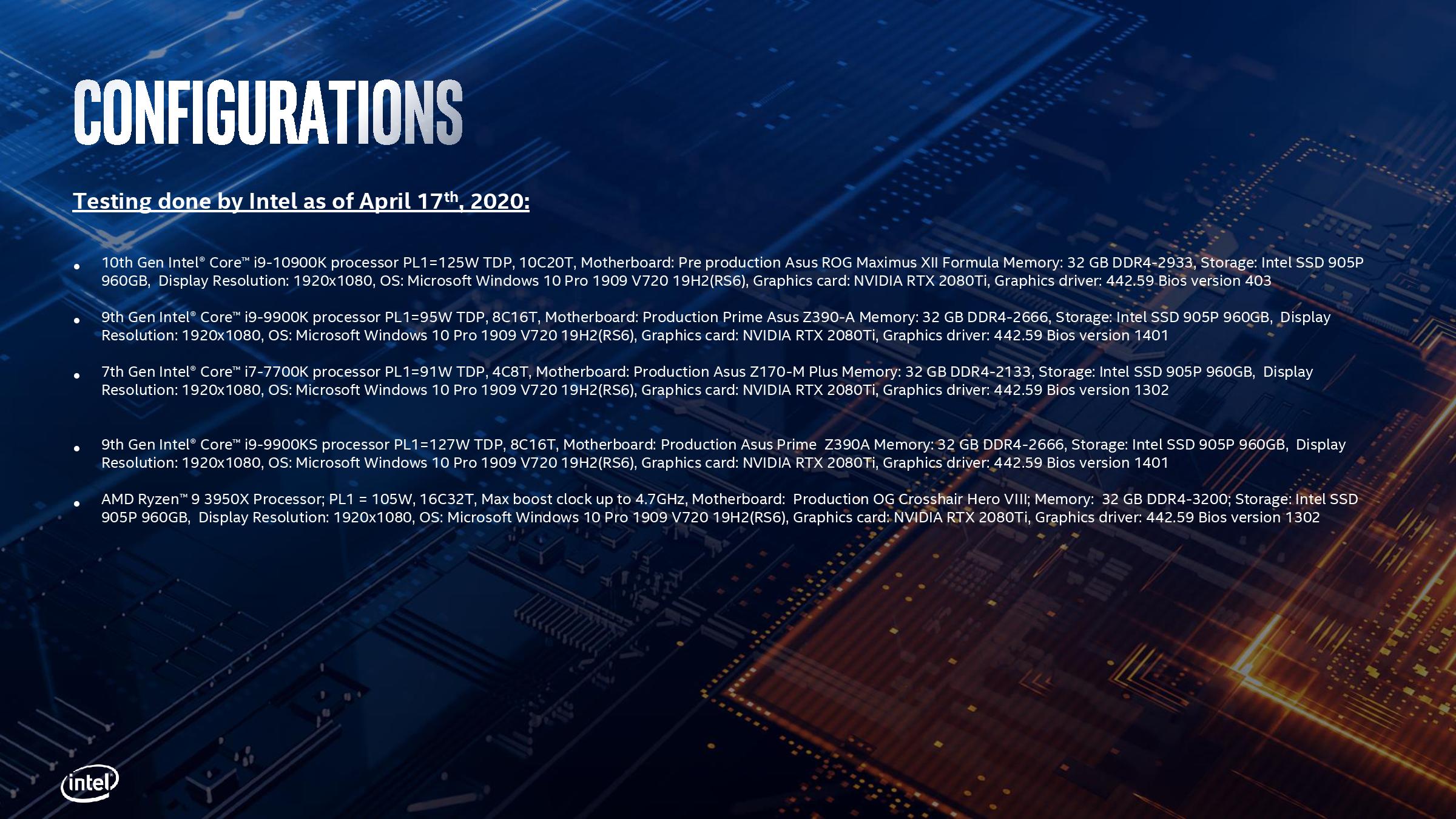


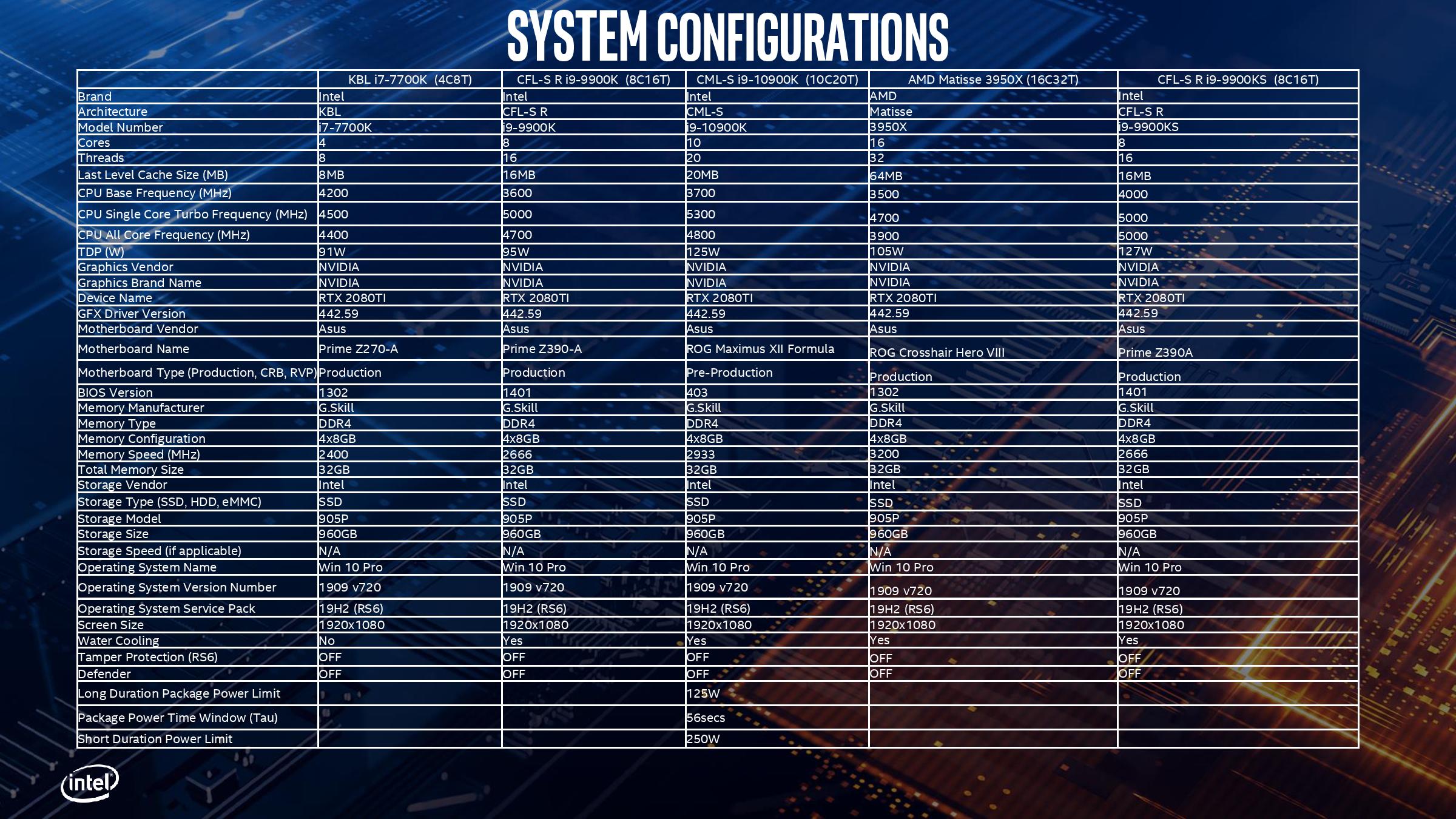
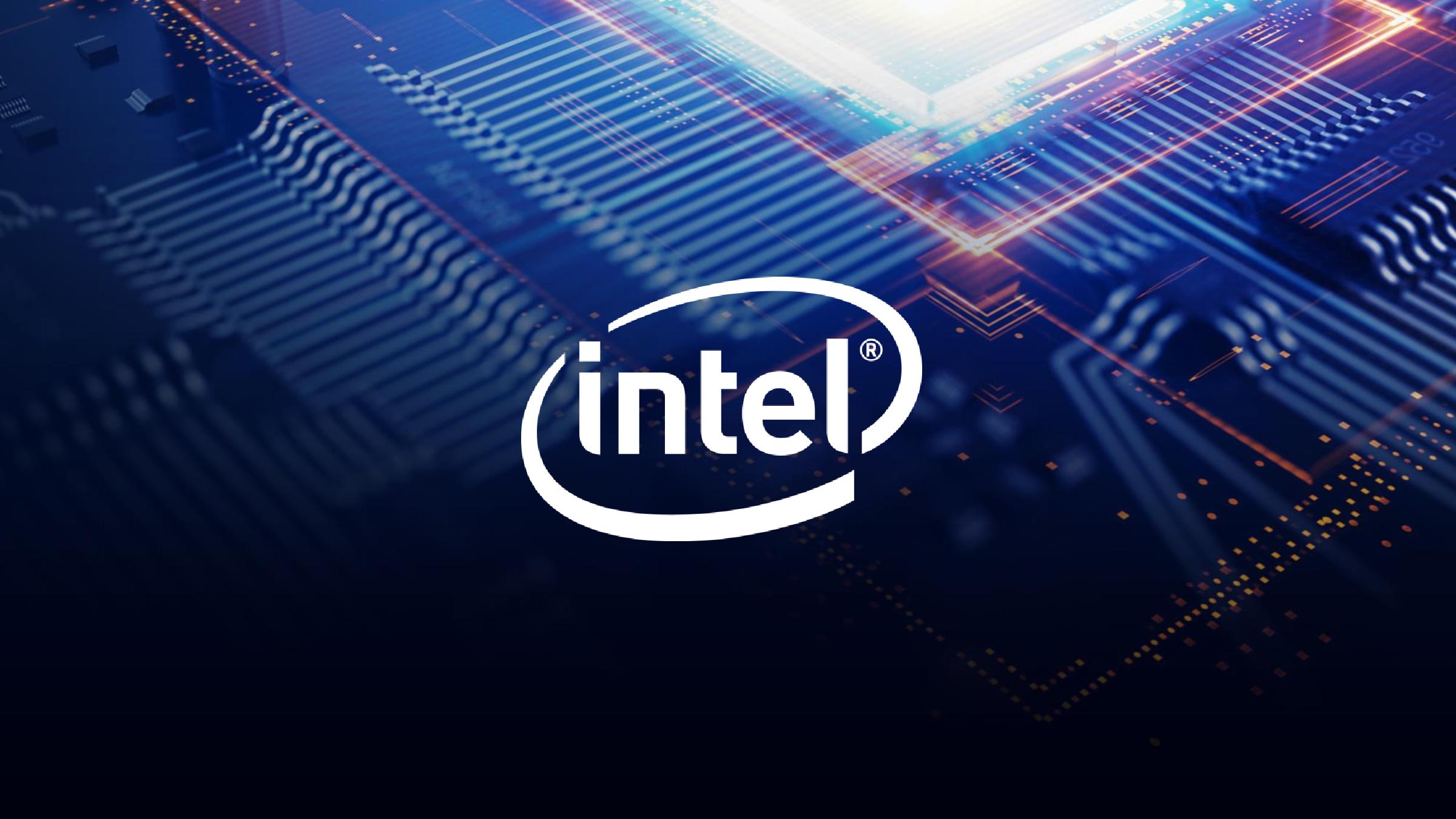
Here's Intel's full slide deck for the Comet Lake-S Launch. However, as with any vendor-provided benchmarks, take all performance claims with a grain of salt and be sure to peruse the footnotes for relevant information.
For instance, in the first row of results on the "Elite real-world performance for gaming" slide, Intel claims anywhere from a 10% to 33% increase in fps and an 18% improvement in 4K video editing, but the performance slide doesn't include the most important information—like the processors tested. Intel generated these results by comparing the 10-core 20-thread Core i9-10900K to the previous-gen eight-core 16-thread 9900K, which isn't an apples-to-apples comparison. It's also noteworthy that these gains occur in games optimized for Intel's architectures through partnerships with game developers.
Intel's second row of test results show massive gains against a three-year-old PC, in this case one armed with a Core i7-7700K.
Intel Comet Lake Pentium Gold
| Model | MSRP | Cores / Threads | Base / Boost GHz | L3 Cache | TDP | PCIe | Memory |
|---|---|---|---|---|---|---|---|
| Pentium Gold G6600 | $86 | 2 / 4 | 4.2 | 4 | 58 | 16 Gen3 | Dual DDR4-2666 |
| Pentium Gold G5600 | $82 | 2 / 4 | 3.9 | 4 | 54 | 16 Gen3 | Dual DDR4-2400 |
| Pentium Gold G6500 | $75 | 2 / 4 | 4.1 | 4 | 58 | 16 Gen3 | Dual DDR4-2666 |
| Pentium Gold G6400 | $64 | 2 / 4 | 4.0 | 4 | 58 | 16 Gen3 | Dual DDR4-2666 |
| Pentium Gold G5400 | $64 | 2 / 4 | 3.7 | 4 | 58 | 16 Gen3 | Dual DDR4-2400 |
| Celeron G5920 | $52 | 2 / 2 | 3.5 | 2 | 58 | 16 Gen3 | Dual DDR4-2666 |
| Celeron G5900 | $42 | 2 / 2 | 3.4 | 2 | 58 | 16 Gen3 | Dual DDR4-2666 |
Intel also refreshed its Pentium Gold and Celeron lineups. The former series often makes a good pairing with super low-end gaming builds, but scoring the chips anywhere near recommended pricing has always been a challenge.
The new Pentium Gold models come with faster DDR4-2666 memory support and a 300 MHz increase to the base clock (there is no boost), but otherwise are similar to their predecessors. This end of the market is, by Intel's own admission, among its lower priorities. As such, it isn't surprising to see the relatively lackluster refresh.
Intel Comet Lake T-Series
| Model | MSRP | Cores / Threads | Base / Boost GHz | L3 Cache | TDP | PCIe | Memory |
|---|---|---|---|---|---|---|---|
| Core i9-10900T | $439 | 10 / 20 | 1.9 / 4.6 | 20 | 35 | 16 Gen3 | Dual DDR4-2933 |
| Core i7-10700T | $325 | 8 / 16 | 2.0 / 4.5 | 16 | 35 | 16 Gen3 | Dual DDR4-2933 |
| Core i5-10600T | $213 | 6 / 12 | 2.4 / 4.0 | 12 | 35 | 16 Gen3 | Dual DDR4-2666 |
| Core i5-10500T | $192 | 6 / 12 | 2.3 / 3.8 | 12 | 35 | 16 Gen3 | Dual DDR4-2666 |
| Core i5-10400T | $182 | 6 / 12 | 2.0 / 3.6 | 12 | 35 | 16 Gen3 | Dual DDR4-2666 |
| Core i3-10300T | $143 | 4 / 8 | 3.0 / 3.9 | 8 | 35 | 16 Gen3 | Dual DDR4-2666 |
| Core i3-10100T | $122 | 4 / 8 | 3.0 / 3.8 | 8 | 35 | 16 Gen3 | Dual DDR4-2666 |
| Pentium Gold G6500T | $75 | 2 / 4 | 3.5 | 4 | 35 | 16 Gen3 | Dual DDR4-2666 |
| Pentium Gold G6400T | $64 | 2 / 4 | 3.4 | 4 | 35 | 16 Gen3 | Dual DDR4-2666 |
| Celeron G5900T | $42 | 2 / 2 | 3.2 | 2 | 35 | 16 Gen3 | Dual DDR4-2666 |
Intel's T-series processors sacrifice clock speeds in the name of slotting into a lower power envelope that often offers a superior level of efficiency. These chips are especially attractive to small form factor builders. There's a low power part to match every full-powered non-K part in Intel's Comet Lake stack, so options abound.
Get Tom's Hardware's best news and in-depth reviews, straight to your inbox.
Current page: Intel Comet Lake Pentium Gold, Celeron, T-Series and Press Deck
Prev Page Die-Thinning, Overclocking, Dynamic Hyper-Threading, Mitigations
Paul Alcorn is the Editor-in-Chief for Tom's Hardware US. He also writes news and reviews on CPUs, storage, and enterprise hardware.
-
tummybunny There seems to be a huge market that only buys Intel so we shouldn't feel sorry for them, but the comparisons between this and Zen 3 later on in the year will surely be devastating.Reply
Hopefully their supply issues are under control at least. -
alceryes Another review with some different details -Reply
https://www.anandtech.com/show/15758/intels-10th-gen-comet-lake-desktop
I don't think Intel is going to do too well with these. Requiring a new socket/chipset and releasing yet ANOTHER 14nm iteration chip is the wrong move when you're back on your heels after a very strong AMD release. -
TCA_ChinChin Better than before but the question is will it be enough for Zen 3? It'll probably convince some who are upgrading but anyone who has an AM4 chipset isn't going to be impressed. An i7 + new mobo = 400$ while just waiting for r5-4600 = 200$. Also overclocking is still locked to K series chips. The fact that Intel still has enough hubris to continue artificially segmenting products to this degree makes me sad.Reply -
Math Geek 250w for STOCK speeds!!! so prob breaking 300w with any type of overclocking. even the i3 was 182w peak at stock speeds. gonna need water-cooling for an i3 at this point.Reply
the fx series when it got this bad would only run on a select few motherboards that could handle the power draw. the intel fanboys threw around terms like space heater and many others to describe how crazy these power levels are. so new socket, expensive mobo to deliver the power, water cooling just to run at stock speeds and this is a big fat NOPE for me.
something tells me though that these new chips will get a good spin from the fan boys. i mean come on who doesn't need an extra space heater in the basement. that's a heck of a value feature from intel........blah blah blah -
jeremyj_83 These TDPs and PL2 numbers are insane. I'd be afraid to use a HSF that isn't a Noctua-D15 on even the T series CPUs.Reply -
Math Geek Replyjeremyj_83 said:These TDPs and PL2 numbers are insane. I'd be afraid to use a HSF that isn't a Noctua-D15 on even the T series CPUs.
i don't think i'd use air for anything above the i3 and then i'd consider a small AIO instead. once you approach 200w, then air just becomes too little too late. it'll throttle continuously and not perform at even stock levels on air. -
JarredWaltonGPU Reply
Intel is basically in the same place AMD was in with the Bulldozer series of CPUs: it has to release something new. Of course, Intel is also about 10X the size/profitability of AMD. And so we get a power increase, slightly higher performance, same old architecture with a few minor tweaks and two more cores.TCA_ChinChin said:Better than before but the question is will it be enough for Zen 3? It'll probably convince some who are upgrading but anyone who has an AM4 chipset isn't going to be impressed. An i7 + new mobo = 400$ while just waiting for r5-4600 = 200$. Also overclocking is still locked to K series chips. The fact that Intel still has enough hubris to continue artificially segmenting products to this degree makes me sad.
Anyway, yeah, I don't think Comet Lake is going to be a massive leap forward. It feels a lot like the Broadwell launch of 2015: too little, too late. What's really shocking is that Intel also has Rocket Lake coming presumably next year. That will also be 14nm+++ but will use the new Golden Cove cores, maybe integrated Xe Graphics as well? But still on 14nm, man... I don't know what to think.
AMD via TSMC has had equivalent process tech since mid-2019, and Apple launched 7nm chips via TSMC in 2018. And Intel still has plans for a 14nm desktop high performance part in 2021? I guess that's the chip that will really go away quickly, once we get Ice Lake or Tiger Lake or whatever (10nm) on desktop.
If AMD can make Zen 3 scale to higher frequencies (5GHz+) and improve IPC a bit more relative to Zen 2, it should finally manage to win every single meaningful comparison against Intel. Right now, AMD wins on cores and power and efficiency, it's close on IPC, but it clocks about 400-800MHz slower. All-core 5-5.1GHz overclocks on Intel are easy enough, and even 'stock' is 4.7GHz all-core. AMD all-core overclocks are more like 4.2-4.3GHz, and stock is only 100MHz lower. So, bump up those clocks for AMD and it can close the last remaining gap. -
JarredWaltonGPU Reply
A good air cooler technically shouldn't be much worse than a good AIO. One just makes it much easier to use a lot of fans and a big radiator. But dual 140mm fans on an air cooler should be pretty close to a 280mm radiator with an AIO -- and you don't have to deal with pumps. My biggest complaint about large air coolers is that they're a pain -- they block RAM slots, and some are so large that they won't fit on many boards.Math Geek said:i don't think i'd use air for anything above the i3 and then i'd consider a small AIO instead. once you approach 200w, then air just becomes too little too late. it'll throttle continuously and not perform at even stock levels on air.
Also, be wary of inexpensive AIOs. I've had multiple AIOs from Enermax fail, for example. Also a couple of previous gen Corsair models stopped cooling properly, and I don't know why -- H115i, and the pump and fans still work but it can't even cope with an i7-8700K (hits 90C+ at stock), never mind faster chips. NZXT is my go-to AIO now, but they're a lot more expensive than some of the other options. -
irish_adam Reply
From the reviews I have seen premium air coolers out perform almost all AIO liquid coolers bar 1 or 2, you'll need a custom loop to really get any better thermals.Math Geek said:i don't think i'd use air for anything above the i3 and then i'd consider a small AIO instead. once you approach 200w, then air just becomes too little too late. it'll throttle continuously and not perform at even stock levels on air. -
alceryes Reply
I disagree.irish_adam said:From the reviews I have seen premium air coolers out perform almost all AIO liquid coolers bar 1 or 2, you'll need a custom loop to really get any better thermals.
I've seen the reviews that don't show AIOs in a good light and some of them don't test properly (e.g. they don't turn the pump up to 'performance' - a few degrees temp gain with no audible increase if the case has ANY fans). I can only go by my direct experience and 'good' AIOs, like my H80i V2, are at least a match for the high end Noctuas. One of the problems is that more and more AIOs have entered the playing field in the last 3-5 years and, just like crappy air coolers, many of them are also crappy.